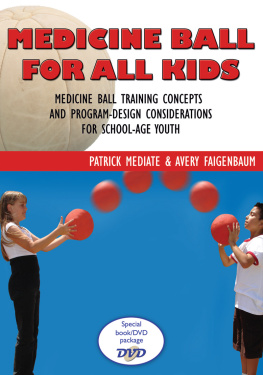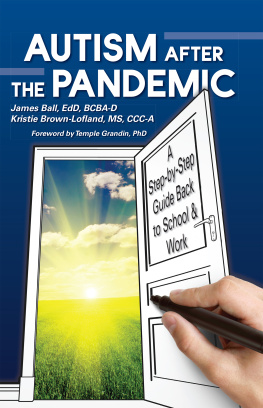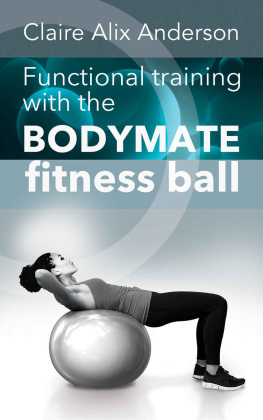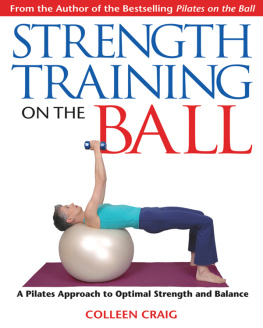Medicine Ball for All Kids
Medicine Ball Training Concepts and
Program-Design Considerations for
School-Age Youth
Patrick Mediate
Avery Faigenbaum

2007 Healthy Learning. All rights reserved. Printed in the United States.
No part of this book may be reproduced, stored in a retrieval system, or transmitted, in any form or by any means, electronic, mechanical, photocopying, recording, or otherwise, without the prior permission of Healthy Learning. Throughout this book, the masculine shall be deemed to include the feminine and vice versa.
ISBN: 978-1-58518-056-1
Library of Congress Control Number: 2007931645
Cover design and book layout: Bean Creek Studio
Front cover photo: Brennan Tiffany
Text and back cover photos: Dave Cartularo, Susan Tucker, and Pat Mediate
Healthy Learning
P.O. Box 1828
Monterey, CA 93942
www.healthylearning.com
Acknowledgments
We want to thank the many gifted individuals who have helped us produce this book. We are most grateful for the support of Dr. Jim Peterson and his staff at Healthy Learning, who encouraged us to pursue our interest and write a book about medicine ball training specifically for school-age youth. We are indebted to our colleagues, who commented on previous drafts of our text, and are most appreciative of our wonderful models who demonstrated correct exercise technique for the photos. We greatly appreciate the efforts of Jim McFarland from Hillsborough School District in New Jersey and the physical education staff from the Greenwich School District in Connecticut for supporting our physical education programs and youth fitness research. We also appreciate the many children and adolescents who have participated in our programs and the college interns who have provided outstanding instruction and leadership. Finally, we deeply appreciate the support and encouragement from our families and friends.
Preface
Today, physical education teachers and youth coaches are incorporating a variety of lifetime physical activities into their classes and sports programs. Not only are developmentally appropriate activities enjoyable and challenging for children and adolescents, but adding variety to the lesson also provides students with an opportunity to demonstrate competency in many different movement forms. In addition to aerobic activities such as rollerblading and relay races, a growing number of boys and girls are participating in strength-building activities. Despite outdated concerns associated with youth resistance training, the American Academy of Pediatrics, the American College of Sports Medicine, and the National Strength and Conditioning Association support and encourage participation in resistance-training programs provided that appropriate training guidelines are followed. Moreover, the National Association of Sports and Physical Education recognizes the development of muscular strength and endurance as an important component of health-related fitness for school-age youth.
In addition to weight machines, barbells, and dumbbells, medicine balls are becoming increasingly popular in schools, YMCAs/YWCAs, and youth sport training centers. Medicine balls were originally used in Europe in the 1920s to restore muscle function in patients and gained popularity in the United States in the late 1920s when White House physician Admiral Joel Boone invented a game with medicine balls called Hoover-ball. This game was specifically designed to keep President Hoover physically fit and was played with teams of two to four players who tossed a six-pound medicine ball over a net eight feet high on a court similar to tennis. Medicine balls can now be found in schools, fitness centers, sports practice fields, and personal-training studios.
Unlike weight machines that train individual muscles or muscle groups, medicine ball exercises train the body to function as a unit instead of as separate parts. It is the creation of these so-called purposeful movements that mimic natural body positions and movement speeds that occur in daily life and game situations that makes medicine ball training so challenging, worthwhile, and enjoyable. We discovered how beneficial medicine ball training can be when we incorporated medicine ball exercises into our physical education classes and youth fitness programs. Due to the dismal performance of high school students on standardized physical fitness testing, we developed a fitness program that consisted of a variety of medicine ball exercises designed to improve physical fitness, enhance self-confidence, and increase sensory awareness through visual, auditory, and tactile stimulation. We called our program medicine ball for all simply because it utilized medicine balls and was purposefully designed to be appropriate for all school-age children regardless of body size or fitness ability.
Our results were so impressive and the students enjoyed the program so much that we implemented our medicine ball for all program into all physical education classes at Greenwich High School. The following year the school was ranked as one of the top schools in the state of Connecticut for physical fitness testing. Since our findings have important practical relevance for designing physical education lessons for elementary and middle school students too, our medicine ball for all program is now a part of a district-wide physical education curriculum in first though twelfth grade. Our system-wide approach to fitness training has enabled all grade levels to rank among the very best in the state in physical fitness testing. Data from our research as well as observations from teachers indicate that marked improvements in fitness performance in our students are directly related to the incorporation of medicine ball activities in our physical education classes and after-school programs. Not only do students look forward to medicine ball training, but teachers and coaches enjoy being part of a program that provides all students with an opportunity to enhance their physical fitness while having fun.
Our research and years of experience indicate that with qualified instruction and age-appropriate program design, medicine ball training can be a safe, enjoyable, and interesting activity for children and adolescents of all abilities. For a physical education teacher or youth sport coach, having the ability to design safe and effective medicine ball training programs for children and teenagers is a valuable professional asset. In this book, we explain the essentials of our medicine ball for all program and describe training procedures that can be used for enhancing health and fitness in elementary, middle, and secondary school children. Of course, our ultimate goal is to teach students how to remain physically fit so that they become active for life. We encourage you to share your ideas about medicine ball training with others and make use of continuing education conferences and the reference list at the end of our book to further your knowledge.
Definitions
Adolescents: Boys and girls aged 13 to 18 years
Agility: The ability to quickly decelerate, change direction, and accelerate again
Balance: The maintenance and/or control of a body position
Children: Boys and girls aged 5 to 12 years
Coordination: The ability of various muscles to work together to produce a specific movement
Exercise: Physical activity designed to maintain or enhance physical fitness












